Tuning
Strings are usually numbered from floor 1 to 4, that is when you hold the instrument as house levels.
The usual tuning of soprano, concert and tenor ukulele is so called "GCEA" or tuning to C (the sound you get when playing empty strings is chord C6). Baritone ukulele is tuned DGBE.
The ukulele has usually the string G tuned one octave higher than you would expect, that is string 4 (first from top) sound higher tone than next string 3 (second from top). Some peole use strings where the G string is thicker and sounds one octave lower (so called low G), then the G C E A strings from 4 to 1 (from top) sound each next higher tone, similar like on guitar.
The usual tuning GCEA (using high G):
direction: from ceiling to floor
string number: 4 3 2 1 tone G C E A frequency (Hz): 392 262 330 440
For tuning it is best to use a "clip" tuner which you attach to instrument head end, above the tuner pegs. The nicest one looks like Rudolf It should be "chromatic" tuner. Or you can use some tuner application for smartphone, e.g. gStrings for Android (this one shows also the frequency, which may be helpful for someone who has no idea how high the ukulele is tuned generally).
You can tune also according to another ukulele, or according to piano: tone C (string 3) is the middle while key C on piano, tones E, A, G (strings 2, 1, 4) are keys E, G, A on piano on the right side to the middle C key (2, 4 and 5 keys far from C).
If just one string get out of tune, you can tune it according to other strings:
- string 4 (top one) should sound on second fret the same as empty string 1 (bottom one)
- string 3 (second from top) should sound on 4th fret the same as empty string 2 (second from bottom)
- string 2 (second from bottom) should sound on 5th fret the same as empty string 1 (bottom one)
New strings are usually marked by number, which one is which (G and A are easy to mix). It takes few days for the new strings to settle and you have to tune up often, that is normal. Use strings for your ukulele size, don't try metal strings (those have higher tension and can damage instrument).
Fingers numbers
Fingers on left hand are for chord pictures or tablatures numbered from index finger, that is 1 = index finger, 2 = middle finger, 3 = ring finger, 4 = little finger (pinkie).
The chord diagrams can indicate which finger to use to hold each string - take that only as advice, many chords can be held more ways, use what is comfortable for you.
Chords
Chord table for download.
For most songs some 3 or 4 chords are enough. The most common (and easiest) tone key for ukulele is "C" and these three basic chords belong to it: C, F, G7.


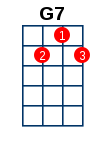
Another handful chords you may meet in songs in C tone key: G, Am, Dm

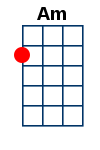
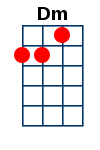
Other usual tone keys and basic chords are:
tone key D: chords D, G, A7, tone key F: chords F, Bb, C7
tone key G: chords G, C, D7, tone key A: chords A, D, E7
Tone and chords letters: the international way is 7 basic tones C D E F G A B, or including halftones C C# D D# E F F# G G# A Bb B (total 12 halftones). (In Czech Republic you meet tone H which is the same as international B, and you may meet Czech B meaning international Bb. Fortunately usually even in Czech notation the Bb is used).
Each tone from those 12 halftones (C C# D D# E F F# G G# A Bb B) can be found easily on ukulele fretboard - one fret corresponds just one halftone. Example: string 1 being empty is A, on first fret it is Bb, on second B, on third C etc.
Tone names: e.g. C# reads C sharp, Ab reads A flat, Bb reads B flat.
Types and names of chords: major - e.g. C can be read as C chord or major C chord (in Czech "dur"), minor - Am or Ami read A minor chord (in Czech "moll"), seventh G7 reads G7.
It is also good to know that (at least on ukulele) the following is true: C# = Db, D# = Eb, F# = Gb, G# = Ab, A# = Bb.
Table of usual chors
C tone key






D tone key

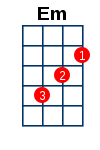


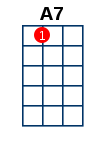
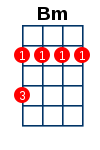
F tone key

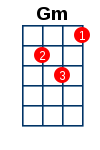
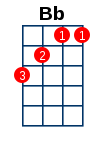
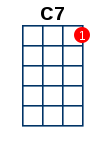


G tone key




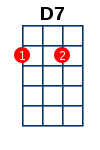

A tone key





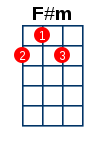
When you encounter an unknown chord in a song, you have three choices what to do:
- you can usually replace it with the basic chord of the same 'letter"
- you can find it in bigger chords table
– jakýkoliv akord lze nahradit tzv. akordem “Z”. Tento velmi důležitý akord zahrajeme tak, že levou rukou Ztlumíme všechny struny 🙂
Další informace o akordech najdete na stránkách seriálu Jak na uke akordy od Jiřího Cvrkala:
2 - Main chords, 3 - Secondary chords, 4- Turnarounds, 5 - Minor tonal keys, 6 – Mimotonální dominanty
Chords with slash: sometimes you meed chords that are written like C/G. Usually the letter after slash indicated tone that should be played as the lowest one, usually bass players are interested in that. It can be tone that is part of that chord, or even some other tone which first in the melodic line. When playing ukulele, you can usually simply ignore the part after slash.
Transposition
Návod na jednoduchou pomůcku na transpozici najdete na stránce Jak na uke akordy 1 – Transpozice.
Accompaniment types
When learning new song, first concentrate on chords only - just left had, and use the simplest strum by right hand (e.g. just down, down..)
The accompaniment style you can then try separately with strings muted by left hand and concentrate only on the rhytm right hand.
Only after that use both hands at the same time.
D means Down, U means Up. Counting for practise: one and two and three and four (on "one" hand goes down, on "and" up)
Počítání pro nácvik: raz a dva a tři a čtyř (na “raz” jde ruka dolu, na “a” nahoru, na “dva” dolu a td.)
Usual strum patterns - 4/4 measure: 1 2 3 4 1: D - D - D - D 2. D U D U D U D U 3. D - D U D - D U 4. D – D U – U D - 5. D – D U – U D U 6. D – D – D U D U
Usual strum patterns - 3/4 measure:
1 2 3 1: D - D - D 2. D U D U D U 3. D – D U D - 4. D – D U D U
Don't be afraid to create any pattern you like. Practise with metronome (there is application for smartphone), better slowly.
Projděte si článek Jak hrát rytmus na ukulele od Jiřího Cvrkala.
What to play
Play what you like :-)
There are many servers on Internet with songs and chords, e.g (Czech) http://www.supermusic.cz. There may be the advantage of possibility to transpose song (move whole song down or up) to different tone key - such that is easy to play and / or to sing.
Šikovná je také aplikace „Zpěvník“ pro chytré telefony či tablety (Android), která umí vyhledat píseň na více serverch a uložit si ji (a také umí transponovat).
You can find more links to chords, tablatures etc on page Learning.
Various tips
When learning new song, play slowly, but precisely. Speed up only after you make no mistakes.
Try to search for the song (e.g. on Youtube) in the same tonal key and play along.
Some servers can show chords for a song while playing, e.g.:
http://www.ukulele.nl/playalong/ - just some song, but very good
https://chordify.net/ – k jakékoliv písni z Youtube, akordy se snaží “vypočítat” takže nejsou přesné, ale často to stačí.
Aplikace Riffstation (pro win a ios) usmí také detekovat akordy k písni, a umí i trnsponovat akordy zároveň se zvukem.
Play with others !
Use your thumb to support ukulele neck, hold the strings by finger tips a bit more closely to frets. On the left hand keep you nails short.
General rule - use index finger (1) for first fret, middle finger (2) for second fret, ring finger (3) for third fret and little finger (4) for 4th fret. But when it is comfortable, no problem a different way.
It is better to practise shorter time but daily than long time.